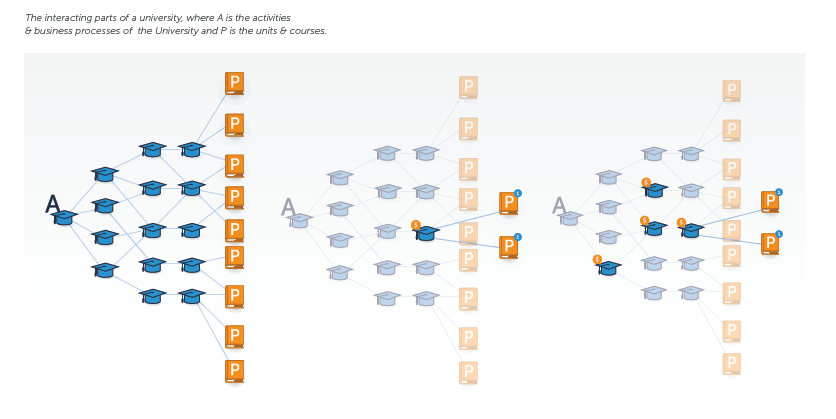
Animated Overview
You can watch a quick two minute overview of the predictive model here: http://youtu.be/eWWQ0exP9-0
Conventional Budgeting
A university is really an array of interacting organisations that not only provide services to staff and / or students but also receive services from other areas of the university.
Let’s say, for example, a faculty requests an increase in funding for a new course or unit.
With conventional budgeting, the university will accordingly adjust the budget to reflect the direct inputs from the faculty, i.e. additional academic staff and some related non-salary costs.
However, while an increase for the new courses may be justified and accurately costed for the teaching faculty, it will also impact other parts of the university. This may mean other areas need more resources as well, for example, HR and IT support.

Understanding Historical Links
With an understanding of historical links across the organisation, a predictive model can be configured.
By applying predictive analysis and using a series of algorithms that mathematically explain the relationships between all the various components of the university, management can begin to see more clearly how changes in one part of the university has affected other areas, and in turn, helps identify the real level of funding and resources required – university-wide.
But How Does it Really Work?
Step 1
We would start at the end with a profile of all existing Units by School and Courses by School with all the current student numbers, timetabling and delivery profiles. Users would add into the model any new courses or units with expected student numbers as well as increases/decreases expected in existing units/courses. Student numbers could be loaded as a feed from student planning. Terminology is different around the globe so for definition purposes we will follow this convention:
- Course = Degree e.g. Bachelor of Engineering
- Unit = Subject e.g. Electronics 101
Step 2
The model will calculate the student numbers for individual units.
Step 3
The model will then calculate the total hours required (Delivery Hours) to support and deliver each unit including:
- Class Time
- Class Preparation
- Student Contact, Marking and Exams
- Unit Administration
Step 4
The model calculates the total teaching pool size (in hours) for each school.
Step 5
The model calculates the total academic FTE (Full-Time Equivalent) required in each school, allowing for sessional staff, research and administrative overhead.
Step 6
The model adds in the School General FTE and Non-Salary Expense requirements to support the academic staff and students.
Step 7
The model adds in the Faculty FTE and Non-Salary Expense requirements to support the school staff and students.
Step 8
The model adds in the University Administrative and Support Staff FTE and Non-Salary Expense requirements. The model will also calculate revenues.
Step 9
The model will then flow the FTE, Expenses and Revenues back through the model to provide the fully burdened expense, revenue and FTE requirements for teaching and research. Teaching is fully detailed down to course and unit instance by student type.
Important Points about the Model
Some key points to note about the construction of the Predictive Model:
- The model can include inflation rates and any expected enterprise bargaining increases for staff salaries
- The model includes a break-down of fixed and variable factors for FTE and Expenses
- The model can include bulk changes in student numbers e.g expecting 5% drop in International Students across the entire university
- The model can include detailed changes in student numbers e.g. expecting an 8% increase in domestic students in Bachelor of Information Technology
- Unit profiles can include Administration and Per Student hours for:
- On Campus
- Off Shore
- External
- Unit profiles can include preparation hours for:
- Lectures
- Repeated Lectures
- Lab
- Repeated Lab
- Practicals
- Repeated Practicals
- Tutorials
- Repeated Tutorials
- Like Student number changes the profiles can be set at a high level and inherited across the university of specifically allocated to individual units.
An important point to note is that to construct a predictive model you must have a series of historical models already constructed, we analyze these prior year models to calculate the algorithms (formulas) that we will use in the predictive model.
Now you are probably thinking to yourself that this all sounds like it will take a huge amount of effort to complete. Luckily, we have been doing it for quite a while now and the timeframe for completion of the primary models can be measured in weeks, we usually allow 6-8 weeks per main model and 3-4 weeks for updates.
These models are not one-time models, they are enduring models. They are purposefully designed to evolve with the university. As the university changes, so will the models.
With modern technology, different delivery platforms for teaching, increasing competition for students things are changing rapidly in the higher education sector and decisions need to be made quickly. Having models pre-built and updated on a regular basis allow university analysts to quickly analyse the models to address the pressing business needs of the university immediately, rather than having to build something from scratch in a spreadsheet as a one-time assessment.
Chart your Future
It’s exciting times for universities at the moment, yes there are financial constraints and governments around the world are reducing the amount of funding instead of increasing it. Also online education and MOOCs seem to be dominating higher education discussions at the moment, rather than being the demise of traditional higher education it will more than likely be an excellent companion. The latest forecasts for the future of higher education are still projecting annual growth and the huge demand seen by the up and coming MOOCs indicate that there is still a massive appetite for higher learning. The future is bright, if you can effectively navigate the troubled waters and the predictive model is the chart to help you do just that.
the issue with many of the schools and students is, accreditation. Many schools mislead students that attain degrees which are unacceptable in the profession especially in consideration of the Human Service field..